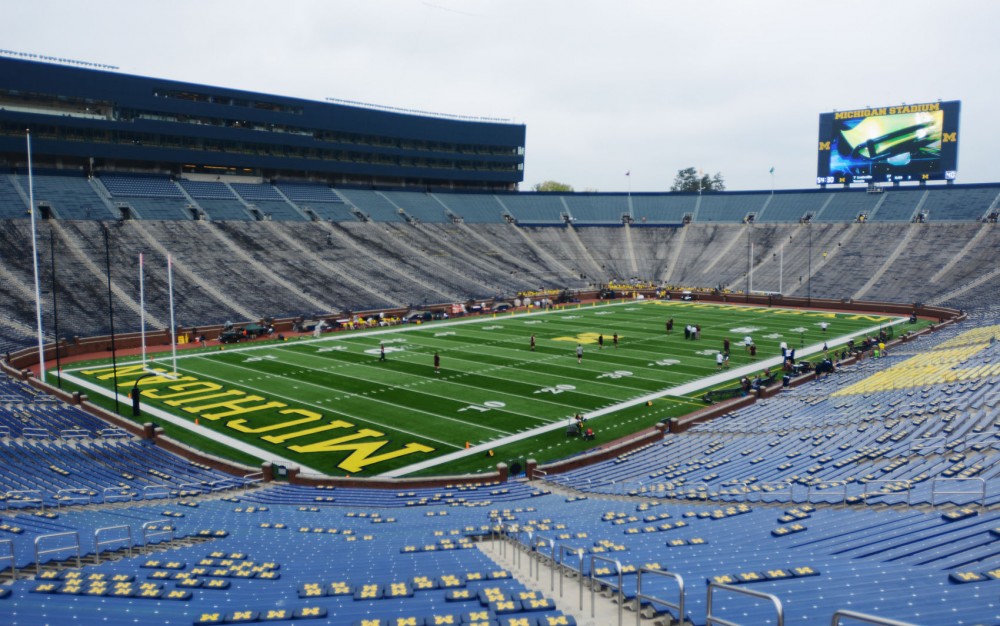Editor’s note: Minnesota Daily sports reporter Jack Satzinger and photographer Chelsea Gortmaker traveled from TCF Bank Stadium to Michigan Stadium in Ann Arbor, Mich., stopping at three historic college football stadiums along the way.
As the car turned onto Interstate 94 East, TCF Bank Stadium loomed large in the rearview mirror.
The Gophers football team’s home stadium holds some of the best amenities money can buy.
It has the largest locker room in all of football at 60 yards long and 25 yards wide. It’s even shaped like a football.
Its scoreboard is bigger than a regulation NBA court at 48 feet high and 108 feet wide and was the first in the Big Ten to broadcast in high-definition.
And behind that scoreboard are stunning views of the Minneapolis skyline and the Mississippi River.
Still, even with these amenities, Minnesota’s 4-year-old stadium doesn’t possess the tradition of other Midwest college football powerhouses.
On the road from TCF Stadium to Michigan Stadium in Ann Arbor, Mich., those differences in culture are evident in the homes of three of the country’s most storied football programs.
Camp Randall Stadium
Camp Randall, located in Madison, Wis., was built in 1917 and is the fourth-oldest venue in the nation.
The land Camp Randall sits on was first used to train Wisconsin troops during the Civil War. Now, it’s the battleground for Badgers football.
Camp Randall may be old, but Wisconsin’s football dominance is somewhat new.
The Badgers’ record was a combined 9-36 in the four seasons before Barry Alvarez was hired as head coach in 1990. Camp Randall, which holds 80,321 people, averaged just 41,734 fans per game in that span.
Now the stadium routinely sells out and is known for its festive atmosphere, especially the “Jump Around” tradition at the start of the fourth quarter, when fans jump up and down to music.
Wisconsin’s crowd is raucous for a reason. The Badgers have made three straight Rose Bowl appearances. Minnesota hasn’t represented the Big Ten in the Rose Bowl since 1962.
Wisconsin’s turnaround is largely credited to Alvarez, who is now the university’s athletics director. A statue of him stands in front of the stadium.
Since 1948, Minnesota and Wisconsin have faced off for the right to take home Paul Bunyan’s Axe — a series the Badgers lead 38-24-3.
In recent years, the “rivalry” has been even more lopsided. Wisconsin has beaten the Gophers nine straight times, but the feel of a Gophers/Badgers rivalry is still potent at Camp Randall.
As some Minnesota fans exited the stadium in Gophers attire, a Badgers security guard said smugly, “I hope we keep that axe from you for a few more years.”
Notre Dame Stadium
Notre Dame Stadium, built in 1930 and located in South Bend, Ind., is the epitome of classic college football tradition.
This legendary stadium still does not have a video board, which allows fans to focus on the game without distractions.
And that’s only the beginning of the story for a facility laced with tradition.
As the Fighting Irish players make their way out to the field before games, they touch a sign that reads, “Play Like A Champion Today.” That tradition has been in place for decades.
Instead of outfitting its field in new-age artificial turf like other programs, including the Gophers, Notre Dame plays on all-natural grass.
The stylistic choice maintains the Fighting Irish’s commitment to tradition but comes at a cost.
Walking through the tunnel onto the field, grounds crew workers toiled away in the mud on a Friday night, replacing old grass with new.
Lining the tunnel onto the field are banners of Notre Dame’s 11 national championships. The Irish made it to the BCS National Championship last season but lost to Alabama.
Notre Dame’s most recent championship win came in 1988, when the team was led by legendary coach Lou Holtz.
Holtz also coached at Minnesota, and the program seemed to be turning around until Notre Dame plucked him away in 1985.
Michigan Stadium
Michigan Stadium is nicknamed “The Big House” for good reason. For its 42-13 win Saturday against the Gophers, it boasted an announced crowd of 111,079.
The stadium has held 100,000-plus fans for 248 consecutive games. TCF Bank Stadium holds only 50,805, and most of the time it isn’t full.
But the Wolverines’ football tradition is bigger than its stadium.
A few blocks away from The Big House is a bar that honors the oldest trophy game in college football: Michigan and Minnesota’s fight for the Little Brown Jug. The Brown Jug Restaurant is a pregame favorite for Wolverines fans, but there were also plenty of Gophers fans there Saturday.
The same could not be said once the game began, when a sea of yellow inundated the stadium while a small Minnesota contingent sat near the remodeled press box.
“When we were warming up out there, I was like, ‘How do they fit 111,000 people in this place?’” redshirt freshman quarterback Mitch Leidner said. “Then we go back out there again … and they’re just stacked all together. It’s a cool atmosphere.”
Built in 1927, the Big House is one of the oldest stadiums in the Big Ten, but its press box experience is anything but archaic.
In 2010, the athletics department spent $226 million to add the new press box and 81 suites. Adding two towers on the east and west ends of the field increased noise in the stadium by 30 percent.
TCF Bank Stadium could also be expanded down the road, with an estimated capacity of 80,000 fans. But if that happens, it won’t be for years and will require a rabid fan base that comes with a winning pedigree.











